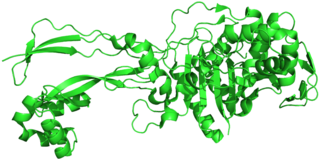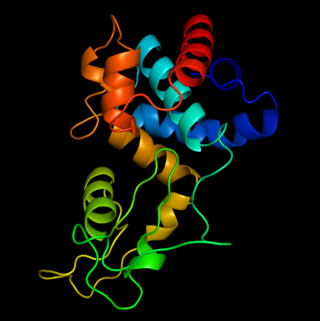
A bacteriophage, also known informally as a phage, is a virus that infects and replicates within bacteria and archaea. The term was derived from "bacteria" and the Greek φαγεῖν, meaning "to devour". Bacteriophages are composed of proteins that encapsulate a DNA or RNA genome, and may have structures that are either simple or elaborate. Their genomes may encode as few as four genes and as many as hundreds of genes. Phages replicate within the bacterium following the injection of their genome into its cytoplasm.

Enterobacteria phage λ is a bacterial virus, or bacteriophage, that infects the bacterial species Escherichia coli. It was discovered by Esther Lederberg in 1950. The wild type of this virus has a temperate life cycle that allows it to either reside within the genome of its host through lysogeny or enter into a lytic phase, during which it kills and lyses the cell to produce offspring. Lambda strains, mutated at specific sites, are unable to lysogenize cells; instead, they grow and enter the lytic cycle after superinfecting an already lysogenized cell.
Autolysins are endogenous lytic enzymes that break down the peptidoglycan components of biological cells which enables the separation of daughter cells following cell division. They are involved in cell growth, cell wall metabolism, cell division and separation, as well as peptidoglycan turnover and have similar functions to lysozymes.

The lytic cycle is one of the two cycles of viral reproduction, the other being the lysogenic cycle. The lytic cycle results in the destruction of the infected cell and its membrane. Bacteriophages that only use the lytic cycle are called virulent phages.

Pseudopeptidoglycan is a major cell wall component of some Archaea that differs from bacterial peptidoglycan in chemical structure, but resembles bacterial peptidoglycan in function and physical structure. Pseudopeptidoglycan, in general, is only present in a few methanogenic archaea. The basic components are N-acetylglucosamine and N-acetyltalosaminuronic acid, which are linked by β-1,3-glycosidic bonds.

Penicillin-binding proteins (PBPs) are a group of proteins that are characterized by their affinity for and binding of penicillin. They are a normal constituent of many bacteria; the name just reflects the way by which the protein was discovered. All β-lactam antibiotics bind to PBPs, which are essential for bacterial cell wall synthesis. PBPs are members of a subgroup of enzymes called transpeptidases. Specifically, PBPs are DD-transpeptidases.
Holins are a diverse group of small proteins produced by dsDNA bacteriophages in order to trigger and control the degradation of the host's cell wall at the end of the lytic cycle. Holins form pores in the host's cell membrane, allowing lysins to reach and degrade peptidoglycan, a component of bacterial cell walls. Holins have been shown to regulate the timing of lysis with great precision. Over 50 unrelated gene families encode holins, making them the most diverse group of proteins with common function. Together with lysins, holins are being studied for their potential use as antibacterial agents.
The Phage-ligand technology is a technology to detect, bind and remove bacteria and bacterial toxins by using highly specific bacteriophage derived proteins.

Enzybiotics are an experimental antibacterial therapy. The term is derived from a combination of the words “enzyme” and “antibiotics.” Enzymes have been extensively utilized for their antibacterial and antimicrobial properties. Proteolytic enzymes called endolysins have demonstrated particular effectiveness in combating a range of bacteria and are the basis for enzybiotic research. Endolysins are derived from bacteriophages and are highly efficient at lysing bacterial cells. Enzybiotics are being researched largely to address the issue of antibiotic resistance, which has allowed for the proliferation of drug-resistant pathogens posing great risk to animal and human health across the globe.
In molecular biology, VanY are protein domains found in enzymes named metallopeptidases. They are vital to bacterial cell wall synthesis and antibiotic resistance.

Epimerox is an experimental broad-spectrum antibiotic compound being developed by scientists at the Rockefeller University and Astex Pharmaceuticals. It is a small molecule inhibitor compound that blocks the activity of the enzyme UDP-N-acetylglucosamine 2-epimerase, an epimerase enzyme that is called 2-epimerase for short.

OBPgp279 is an endolysin that hydrolyzes peptidoglycan, a major constituent in bacterial membrane. OBPgp279 is found in Pseudomonas fluorescens phage OBP, which belongs in the Myoviridae family of bacteriophages. Because of its role in hydrolyzing the peptidoglycan layer, OBPgp279 is a key enzyme in the lytic cycle of the OBP bacteriophage; it allows the bacteriophage to lyse its host internally to escape. Unlike other endolysins, OBPgp279 does not rely on holins to perforate the inner bacterial membrane in order to reach the peptidoglycan layer. Although OBPgp279 is not a well-studied enzyme, it has garnered interest as a potential antibacterial protein due to its activity against multidrug-resistant gram-negative bacteria.
The Phi11 Holin Family constitutes the Holin Superfamily I.
The Phage 21 S Family is a member of the Holin Superfamily II.
The T4 Holin Family is a group of putative pore-forming proteins that does not belong to one of the seven holin superfamilies. T-even phage such as T4 use a holin-endolysin system for host cell lysis. Although the endolysin of phage T4 encoded by the e gene was identified in 1961, the holin was not characterized until 2001. A representative list of proteins belonging to the T4 holin family can be found in the Transporter Classification Database.
The Lactococcus lactis Phage r1t Holin Family is a family of putative pore-forming proteins that typically range in size between about 65 and 95 amino acyl residues (aas) in length, although a few r1t holins have been found to be significantly larger. Phage r1t holins exhibit between 2 and 4 transmembrane segments (TMSs), with the 4 TMS proteins resulting from an intragenic duplication of a 2 TMS region. A representative list of the proteins belonging to the r1t holin family can be found in the Transporter Classification Database.
The Bacterophase Dp-1 Holin Family is a family of proteins present in several Gram-positive bacteria and their phage. The genes coding for the lytic system of the pneumococcal phage, Dp-1, has been cloned and characterized. The holin of phage Dp-1 is 74 amino acyl residues (aas) long with two putative transmembrane segments (TMSs). The lytic enzyme of Dp-1 (Pal), an N-acetyl-muramoyl-L-alanine amidase, shows a modular organization similar to that described for the lytic enzymes of Streptococcus pneumoniae and its bacteriophage in which change in the order of the functional domains changes the enzyme specificity. A representative list of proteins belonging to the Dp-1 family can be found in the Transporter Classification Database.
The Actinobacterial Phage Holin (APH) Family is a fairly large family of proteins between 105 and 180 amino acyl residues in length, typically exhibiting a single transmembrane segment (TMS) near the N-terminus. A representative list of proteins belonging to the APH family can be found in the Transporter Classification Database.
Although cell wall carbohydrates are ideal immunotherapeutic targets due to their abundance in bacteria and high level of conservation, their poor immunogenicity compared with protein targets complicates their use for the development of protective antibodies. A lysibody is a chimeric antibody in which the Fab region is the binding domain from a bacteriophage lysin, or the binding domain from an autolysin or bacteriocin, all of which bind to bacterial cell wall carbohydrate epitopes. This is linked to the Fc of Immunoglobulin G (IgG). The chimera forms a stable homodimer held together by hinge-region disulfide bonds. Thus, lysibodies are homodimeric hybrid immunoglobulin G molecules that can bind with high affinity and specificity to a carbohydrate substrate in the bacterial cell wall peptidoglycan. Lysibodies behave like authentic IgG by binding at high affinity to their bacterial wall receptor, fix complement and therefore promote phagocytosis by macrophages and neutrophils, protecting mice from infection in model systems. Since cell wall hydrolases, autolysins and bacteriocins are ubiquitous in nature, production of lysibodies specific for difficult to treat pathogenic bacteria is possible.
Vincent A. Fischetti is a world renowned American microbiologist and immunologist. He is Professor of and Head of the Laboratory of Bacterial Pathogenesis and Immunology at Rockefeller University in New York City. His Laboratory is the oldest continuous laboratory at Rockefeller that started in 1926 and headed by 4 leading scientists over its near 100-year history: Homer Swift, Maclyn McCarty, Emil Gotschlich and now Vincent Fischetti. Keeping with the historical theme of infectious diseases, Fischetti's primary areas of research are bacterial pathogenesis, bacterial genomics, immunology, virology, microbiology, and therapeutics. He was the first scientist to clone and sequence a surface protein on gram-positive bacteria, the M protein from S. pyogenes, and determine its unique coiled-coil structure. He also was the first use phage lysins as a therapeutic and an effective alternative to conventional antibiotics.








